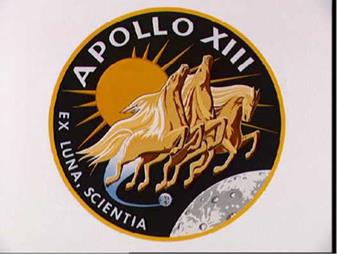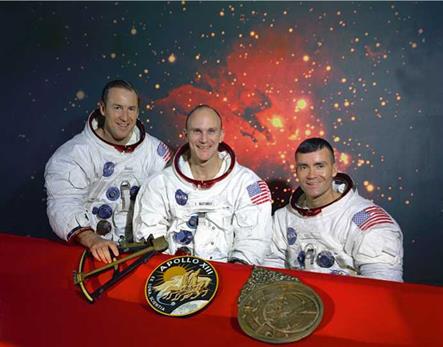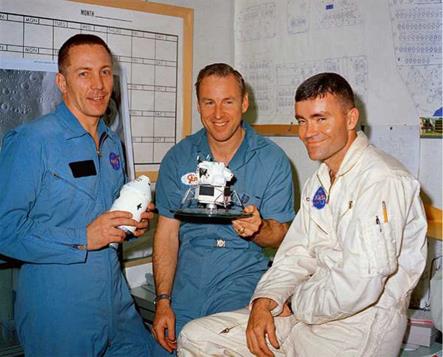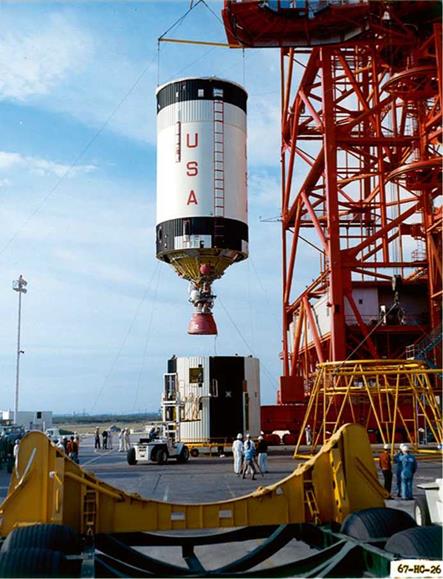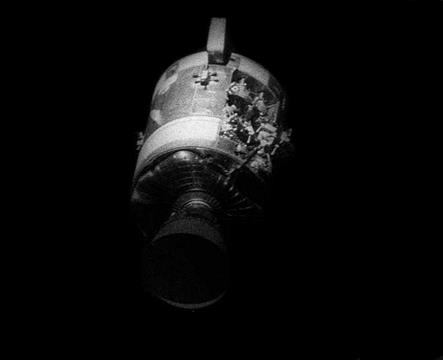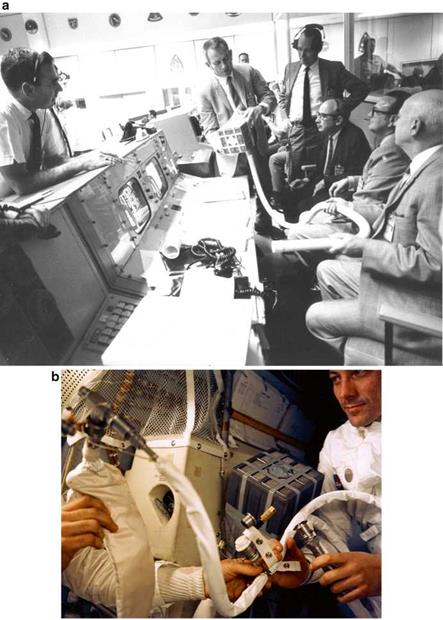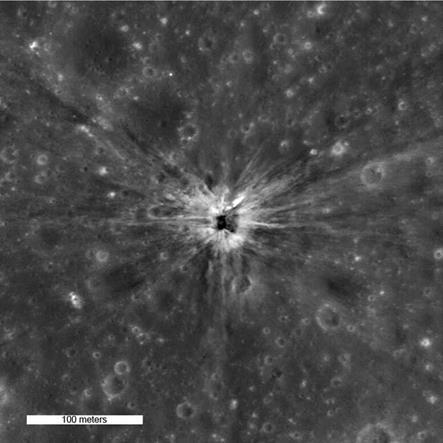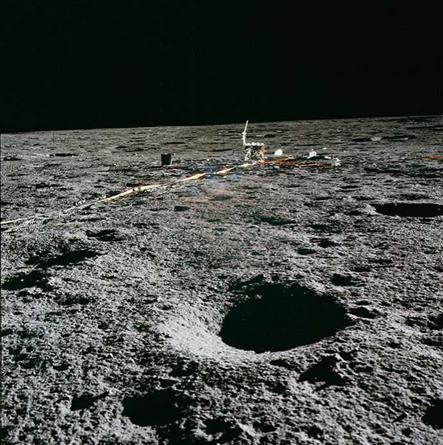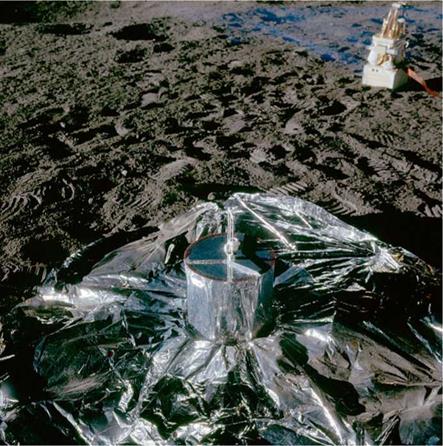Apollo 13
Dates: 11-17 April, 1970
Crew: Commander Jim Lovell CM Pilot Jack Swigert LM Pilot Fred Haise
Command Module: Odyssey Lunar Module: Aquarius
Accomplishments: Successful return to Earth after an on-board explosion.
J. L. Chen, How to Find the Apollo Landing Sites,
The Patrick Moore Practical Astronomy Series, DOI 10.1007/978-3-319-06456-7_5, © Springer International Publishing Switzerland 2014
|
Fig. 5.1 Insignia. Courtesy of NASA |
|
Fig. 5.2 The original Apollo 13 crew of Lovell, Mattingly, and Haise. Courtesy of NASA |
|
Fig. 5.3 The revised Apollo 13 crew picture ofLovell, Swigert, and Haise. Courtesy ofNASA |
|
Fig. 5.4 Pre-Launch Apollo 13 Service Module. Photo courtesy of NASA |
|
Fig. 5.5 Damaged Apollo 13 Service Module that caused the mission to abort. Photo courtesy of NASA |
The inclusion of the Apollo 13 mission in a book about Apollo landings on the Moon may seem odd, since obviously the Apollo 13 failed in its mission to land on the Moon. Apollo 13 is one of the most famous and best remembered manned spaceflights in history, exceeded only by the history making Apollo 11 mission. However, the story of Apollo 13 does include its Saturn S-IVB third stage being targeted to impact the Moon and providing seismic data for the Apollo 12 ALSEP seismometer. Thus, the historic Apollo 13 mission’s inclusion.
Books have been written, a long-forgotten made-for-television movie aired, and a very successful theatrical movie have been produced about this ill-fated mission. Apollo 13 is often described as NASA’s finest moment as the agency successfully returned the astronauts safely home. It is a testament to the many NASA engineers and scientists who brought Lovell, Haise and Swigert to a safe landing.
The genesis of the mission failure was the Oxygen Tank No. 2. The oxygen tank was originally to fly as part of the Apollo 10 mission. The Apollo 10 mission, with the crew of Tom Stafford, John Young, and Gene Cernan, was a planned dry run and prelude to the actual landing on the Moon mission, with all procedures and maneuvers rehearsed with the exception of an actual landing.
During pre-flight testing, Oxygen Tank No. 2 caused a major problem in the Apollo 10 service module. It was removed from the Apollo 10 service module for further testing, inspection, and repair. During the removal, the oxygen tank was dropped and damaged. After repair work was performed, the oxygen tank was then installed onto the Apollo 13 service module, whereupon it failed again during testing. Again, NASA performed some adjustments and deemed the oxygen tank flight worthy. Apparently, the continual maintenance actions performed and the accidental damage resulted in the teflon insulation of the wires to the cyro stir fans becoming frayed.
Oxygen Tank No. 2 was part of a redundant fuel cell system for the CSM that provided power to the CSM system, with the by-product of drinkable water. The redundant fuel cell system was designed with separate units each having a cryogenic hydrogen and cryogenic oxygen tank, separate power buses, and separate indicator and control systems. The hydrogen and oxygen liquid gases tended to settle into layers of different temperatures and densities as the Apollo spacecraft was exposed to the heat of the Sun on one side, and the cold of the unlit side. Since the hydrogen and oxygen tanks were chilled down to their liquid states, it was necessary to perform a “cryo stir” in each of the tanks to maintain a constant internal tank temperature and pressure, and enable sensors to produce consistent readings for the crew and Mission Control telemetry. By flipping on the cryo stir switch, the CM pilot would activate two small fans within each hydrogen and oxygen tank to mix the tanks contents, hence the term cryo stir.
The night of the Apollo 13 explosion, Mission Control was receiving signals from one of the hydrogen tanks that necessitated an extra cryo stir. When Swigert received the order from CapCom Jack Lousma, he flipped the switch for the cryo stir, which caused a spark across the frayed fan wire in Oxygen Tank No. 2, igniting the pure liquid oxygen, and causing the explosion in the service module. The cause of the explosion was not the extra cryo stir. The explosion would have occurred the next day during a scheduled cryo stir. Disaster was inevitable.
As a side note, the actual quote from this historic mission was “Okay, Houston, we’ve had a problem.”, spoken by Jack Sweigert. After CapCom Jack Lousma called back “This is Houston. Say Again, please,” Jim Lovell responded “Houston, we’ve had a problem We’ve had a Main B Bus under volt.” The public’s collective memory has misquoted the line, much of it cemented as a result of the Hollywood movie Apollo 13, replaced the “had” with “have”, changing it to “Houston, we have a problem.” with Tom Hank’s Jim Lowell speaking the line, thus changing the line from past-tense to present-tense. The director of Apollo 13, Ron Howard, changed the line in the movie script in order to create a dramatic effect, but as a result has perpetuated the misquote.
|
Fig. 5.6 (a) Deke Slayton (check jacket) shows the adapter devised to make use of square Command Module lithium hydroxide canisters to remove excess carbon dioxide from the Apollo 13 LM cabin. Photo courtesy of NASA. (b) Interior view of the LM Aquarius during return to Earth. Note: The jerry-rigged lithium hydroxide canister beside Astronaut Swigert. Photo courtesy of NASA |
The impact of the explosion is well documented in books and movies. The loss of the lunar landing, loss of power, the power up issues, the carbon dioxide issue and the jury-rigged oxygen scrubbers (Fig. 5.6a, b), and the computer-less course corrections are all well known. One issue caused by the explosion that is often missed by the public is the loss of drinking water. The fuel cell system, when properly operating, provided both power and water to the spacecraft and the crew. The water could be used to both cool the electrical systems and for drinking by the crew. The Apollo spacecraft therefore did not have to carry huge stores of water to make the flight. The destruction of the fuel cell system caused by the Oxygen Tank No. 2 explosion deprived Lovell, Haise and Swigert of drinking water. Normal water intake for the crew was 75 ounces per person. From the moment of the explosion to splashdown, the Apollo 13 astronauts were limited to 6 ounces of water per day! All three astronauts returned extremely dehydrated, and the kidney infection that Fred Haise suffered during the latter part of the mission was a result of the water shortage.
|
Fig. 5.7 LRO view of the Apollo 13S-IVB Third Stage Impact Site. Photo courtesy ofNASA and Arizona State University |

While the primary mission of Apollo 13 was landing on the Moon, it was forever blasted away by the Oxygen Tank No. 2 explosion. However, one scientifically significant objective was achieved. The Saturn V rocket that rocketed Apollo 13 towards the Moon consisted of a 3-stage launching system. While the first and second stage of the launch vehicle dropped back to Earth after launch, the third stage, known as the Saturn-IVB (or alternatively S-IVB) was used to propel the docked Apollo Command Module and Lunar Module from Earth orbit into a lunar trajectory. The spent S-IVB third stage separated from the Command Module, and was sent on a trajectory to impact the moon north of Mare Cognitum. From the tracking of the radio signals of the rocket, the impact locations on the moon and the impact times were fairly well known, with the impact site confirmed with photos from the 2009 LRO mission.
Seismogram of the Apollo 13 S-IVB impact recorded at the Apollo 12 seismic station in digital units (DU). The three traces designate the signal of the 3 orthogonal components of the ground motion at long wavelengths. The arrows mark the arrival times of the p (primary) and the slower s (secondary) seismic waves. Image modified from: Ewing et al. (1971), Seismology of the moon and implications on internal structure, origin and evolution, in: De Jaeger (Eds.): Highlights of Astronomy, IAU, pp. 155-172)
At the time of the Apollo 13 mission, only the seismometer at Apollo 12 was available, which had been deployed 5 months earlier. The S-IVB impact occurred on April 14, 1970, at a distance of 135 km from that seismic station at longitude 332.11°, latitude -2.56°, elevation 1166 m. The later Apollo missions all took advantage of their third stages by impacting them on the Moon. With an expanding network of seismometers with each subsequent mission, impacting the known size and weight of the S-IVB third stage served as a calibration tool for all the ALSEP seismometers. The impacts by the S-IVB stages represented unique calibration signals for the Apollo seismic station network, which operated on the lunar surface from 1969 to 1977. Since the rocket impacts occurred at known times and places, the seismic wave velocities, in particular those within the upper lunar crust, could be measured directly.
|
Fig. 5.9 Apollo 12 ALSEP including Passive Seismometer Experiment (PSE). Photo courtesy of NASA |
|
Fig. 5.10 Apollo 12 Passive Seismometer Experiment. Photo courtesy ofNASA |
In 2010, a company called Analytical Graphics, Inc. (AGI) used Satellite Tool Kit (STK) software to perform an analysis of the Apollo 13 mission with the somewhat fatalistic assumption that the course corrections failed and NASA was unable to get the Apollo astronauts home safely. The previously accepted thought was the Apollo spacecraft would miss the Earth, the astronauts would die and the CM would drift through space. The AGI analysis revealed a much different outcome. The command module would have missed the Earth by 2,500 miles and entered into an elongated orbit that would have apogee of 350,000 miles. Upon returning Earthwards, Apollo 13 would have passed within 30,000 miles of the Moon, close enough to perturb its orbital path and send the CM towards the Earth and its atmosphere. The STK software then predicted a re-entry on May 20, 1970, 5 weeks after Oxygen Tank No. 2 exploded. Unfortunately, the simulation predicted a steep
re-entry path, with the CM burning up in the atmosphere. This simulated scenario did not take into account the limited expendables on board Apollo 13, such as water, food, and oxygen. Either way, in the case of a failed course correction, the fate of the astronauts was fatal. The results of the AGI analysis was confirmed by Apollo 13 flight controller Chuck Dietrich using historic Apollo 13 flight data. Thank goodness Apollo 13 had a happy ending!
As the CM Odyssey splashdown safely in the Pacific Ocean, some pieces of the LM Aquarius survived re-entry. NASA’s projected trajectory data indicated that pieces of Aquarius landed in the open sea between Samoa and New Zealand. Although the mission was not a complete success, a lunar flyby mission was accomplished, with three planned experiments completed: lightning phenomena, Earth photography, and the S-IVB lunar impact.
After the safe return of Apollo 13, Grumman Aerospace Corporation, the designers and builders of the LM sent a spoof invoice A441066 to North American Rockwell, the designers and builders of the CSM, for towing Apollo 13 around the moon and home to Earth. The bill was submitted by Sam Greenberg, a pilot for Grumman Aerospace, and was written by workers at Grumman’s Flight Control Integration Lab in 1970. Greenberg was apparently fired for it, but was reinstated 2 hours later as Lou Evans, president of Grumman signed the invoice and sent it to Rockwell. It included towing at $4.00 first mile, $1.00 each additional mile, battery charge, oxygen and addition guest at $8.00/night. Water and baggage handling was free. With a 20 % commercial discount and 2 % cash discount (net 30 days), the total bill came to $312,421.24. Rockwell responded in a press conference that they still had not received payment for shipping four of Grumman’s LMs to the Moon!











